For anyone who listened to pop music in the 1990s, the chorus of The Shamen’s Ebeneezer Good will bring a smile (or a grimace) to your face. Despite being banned from the BBC's airways in the UK at the time, this didn’t stop it being enormously successful and it ended up topping the UK’s music charts for 4 weeks in September 1992. While we’re not condoning taking drugs, the line “Though very much maligned and misunderstood, E’s vibe up the place like no other man could” fits so well with the rhetoric behind e-gravel bikes that it was too good not to use. Can the ‘E’s are good’ epithet be applied to e-gravel bikes? Olly takes one of Canyon’s new Grizl:ONs out in to the wilds of Yorkshire in search of gravelly adventure to find out.

“If I was on my own bike I would dead by now,” said Kelvin. “But I’m still getting a proper workout.“ That sums up the benefits of an e-gravel bike in 19 words as eloquently as anything I’ve ever read in the subject. At the point where he made this pronouncement, we were working our way up the third 20% gradient climb of the day. Calderdale, where we were riding, lies close to the border between the UK counties of Yorkshire & Lancashire. The topography of the region is a mix of peaty moorland plateaus and heavily wooded, deeply incised, water-cut valleys. While the moorland plateau areas are generally flat/undulating, getting up to them from the valley bottoms, where the majority of the local residents live, involves some properly hard graft. The incredible industrial heritage of the area has left the region enmeshed with a network of stone-pitched ‘pack horse trails’, former quarry roads, canal side tow paths and ancient railway trackbeds. In short, as long as you like climbing, it’s gravel riding heaven.

“I’m going to take you up a climb I haven’t done for around a decade” said Kelvin, only a few minutes after we left his home. The route he had planned required concentration right from the word go. Overnight rain showers had left the ground liberally coated in a thin layer of Teflon. Almost as soon as we set off, we descended at speed on some off-camber cobbles. Tyres scrabbled for grip. Not-yet-warmed-up synapses fired slowly. Reaction times were not as good as they should have been considering the trail conditions. Big grins spontaneously erupted. Cobbles led to rooty singletrack, led to canal tow path, led to tarmac. We’d only ridden a short distance, but we had already ticked off many of the trail types in the “Spotter’s Guide to Calderdale Gravel Riding” that Kelvin had obviously mentally tucked away in his back pocket.

There isn’t any photographic evidence of the hideousness of the first climb of the day. Even the thought of trying to dig my phone out of my jersey pocket and climb one-handed while shooting is laughable. Kelvin had promised an “alpine-style” ascent and he wasn’t joking. The screen of my bike computer showed distinctive hairpin bends and a gradient that exceeded 20% before my vision started to go slightly blurry and I had to concentrate more heavily on breathing and pedalling smoothly enough to prevent my rear tyre from skipping on the broken asphalt surface. “I used to ride up this pretty often, even on my singlespeed, back in the days when I was commuting over the moors to work” Kelvin told me, as we headed up the steepest pitch “But I don’t ride it anymore, as it’s way too hard a climb to have at the start of a ride”. The fact that he could talk at all, let alone manage a fully coherent sentence was perhaps testament to the bike he was riding. The 55 Nm of peak torque that his Canyon Grizl:ON was generating was playing quite a beneficial role in boosting his ability to both converse and climb. That might sound like I’m being unduly critical of his fitness level, but he would be the first to admit that he was welcoming the extra help of the e-bike motor.

Kelvin and I have ridden together for more than 30 years, which probably explains the ever-increasing number of grey hairs that we now own. We were utterly hooked on mountain biking from the first time we tried it at the start of the 1990s and we honed our craft on the rooty, off-cambered singletrack of our native Welsh Borders. Now living nearly three hours apart, we don’t get to ride together as often as we did in our younger carefree days, but we try to get out on the bikes on three or four weekends a year. With Kelvin’s local trails being primarily steep, rocky and techy, riding mainly on a mountain bike makes much more sense for him. The high level of ‘gnar’ in his local riding inspires a winch-and-plummet riding style and a lot of crazy gradients mean that walking up is often as fast as trying to ride. Tech riding like this is great for honing bike handling skills and confidence on steep, rocky trails but it probably doesn’t do much for aerobic fitness.
My local riding on the other hand is vastly more tame in comparison, but big days out on a gravel bike, friends who race CX in the winter and a shared love among my local ride buddies of pushing our collective fitness levels meant I was significantly happier taking on sustained climbs, while being a little more out of practice riding steeper tech trails! When we first discussed getting together for an early spring weekend of riding, we had initially decided on mountain biking. Partly because it seemed more appropriate for the trails close to Kelvin’s home, but perhaps also as a throwback to our youth. What threw a bit of a spanner into the works was the temporary arrival in my life of the Grizl:ON. Although significantly less well suited to being ridden on techy MTB trails, the boost from the diminutive central motor meant just one thing – some instant syncronising of our relative fitness levels. I figured that if we could eke out enough life from the Grizl:ON’s in-built battery, we could take on a much longer or more challenging (in terms of metres of climbing anyway) route than would otherwise have been fun.
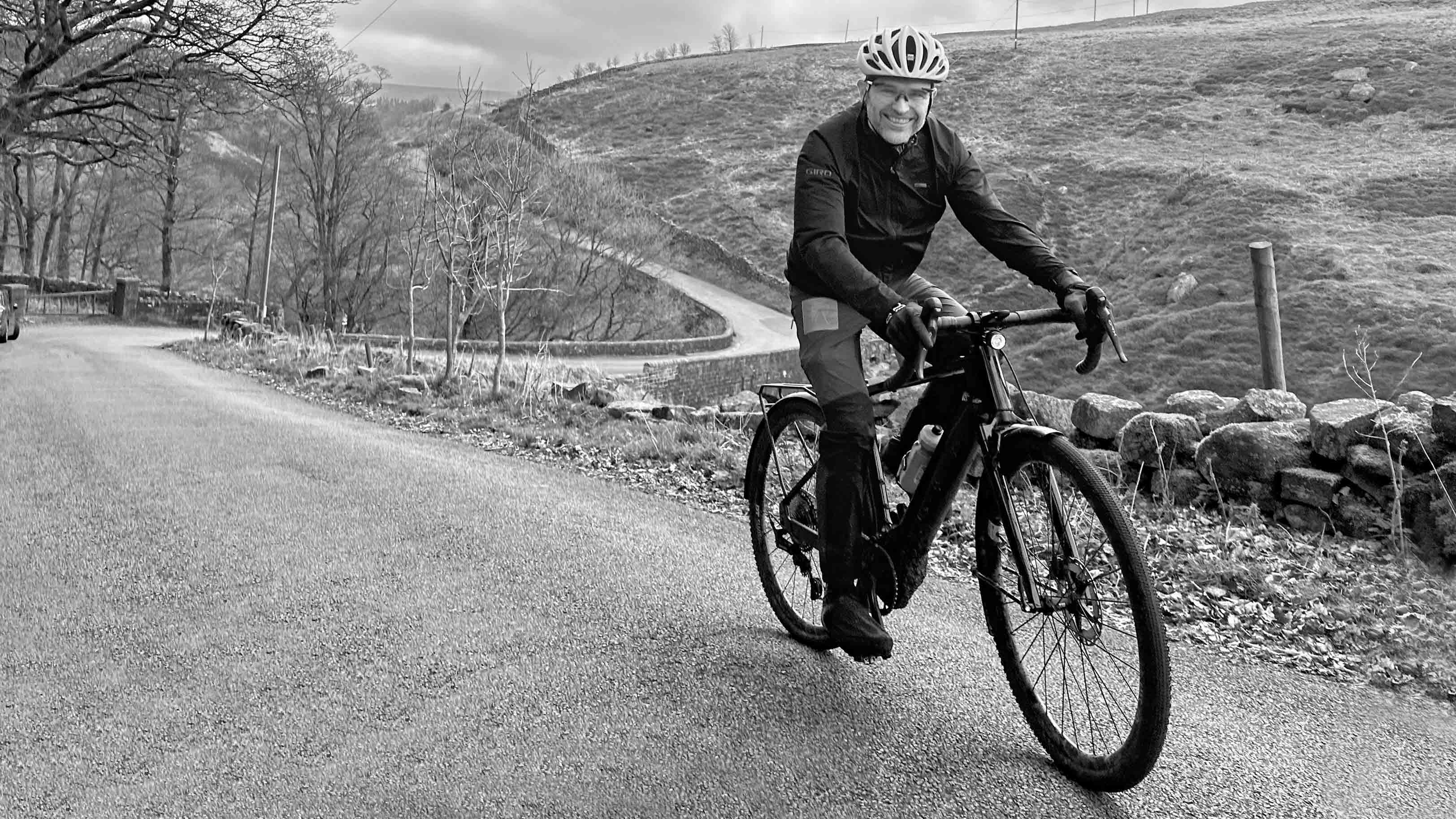
Although this shot won’t win any awards for composition or framing, it does give a super clear guide to what Kelvin thought of the Grizl:ON. Unfortunately, the shot singularly fails to capture quite how steep this road is, how much climbing we had already done or the fact there was a 180-degree hairpin bend and further steep climbing just in front of us. When they first came out, e-MTBs were primarily marketed as speed enhancers – fly up the trails, forget about needing an uplift, don’t worry about being fit etc. While this does arguably apply to e-gravel bikes too, there are two big differences – the main one is the lower levels of power available on a typical e-gravel bike, but it also ignores what is in my view the biggest benefit – a levelling of the playing field. I suspect that all of us have cycling friends who for whatever reason (age, health, time constraints, injury, parental demands etc) have a lower level of fitness than the rest of their ‘gang’. If I was going to market an e-bike of any kind, my main selling point would be that it allows everyone to ride together at more-or-less the same speed.
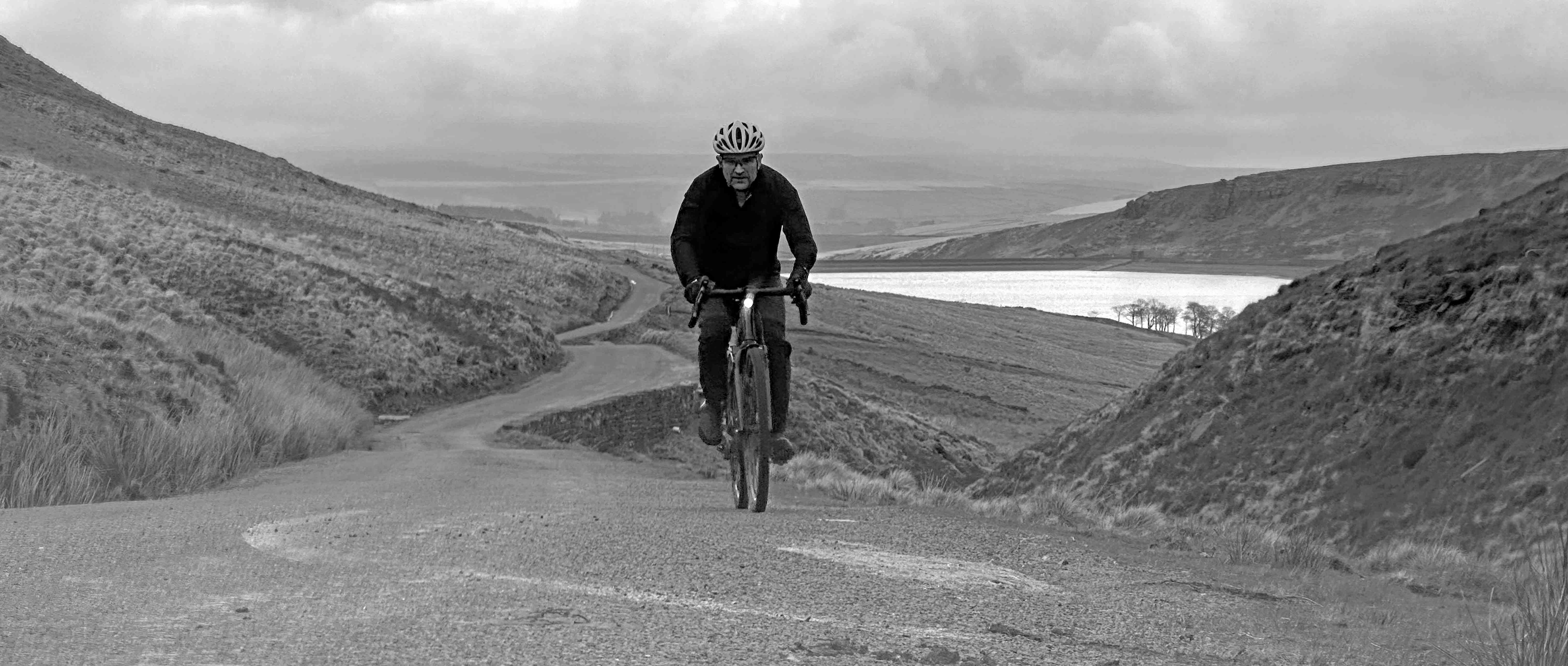
“I’ve got a bit of road that I think you’ll like.” said Kelvin. “It’s normally super quiet and the views are great”. He wasn’t wrong. The road clung to the side of a wide valley and slowly inched its way up to a small pass. The surface was surprisingly good, particularly considering that we were riding at nearly 400m above sea level and the road would be subject to the vagaries of British weather. Of course, there were still plenty of ripples in the tarmac, some patches of loose gravel and margins which were friable and crumbling where two vehicles had pulled across to be able to pass each other. It was basically a perfect gravel bike road and the short ‘kick’ up to the pass itself was the icing on the cake, with great views behind us down to Widdop Reservoir and in front looking down into Lancashire. “I don’t come up very often, but this will take us to a section of trail that you’ll love.”
From the pass, a super-fast and sinuous tarmac descent took us down into the county of Lancashire. We pulled over briefly to let a car get past, but then realised the narrow, twisty nature of the road meant we could descend just as rapidly. After a few minutes of descending Kelvin pulled off to the left side of the road and it became immediately obvious why. To our left, through a set of freshly maintained gates, was a signposted section of the Pennine Bridleway. This long-distance waymarked trail traverses a large section of the moors here and thanks to extensive grant funding, the section we rode was immaculately maintained and was as close to gravel bike heaven as you could wish for.

The initial climb away from the road was an absolute pig. Steep and loose, trying to find a good line while maintaining grip meant shuffling right forward on the saddle and trying to focus on where you wanted the bike to go, rather than looking at the hazards at the trail’s margins. With leg muscles already feeling the strain of the earlier climbs, I’m not sure I won any style points for grace or poise, but I managed to ‘clean it’, so that was something. As I stopped and looked back, Kelvin was practically on my wheel and was actually smiling. The difference that having some motorised assistance made to his enjoyment of the climb was quite incredible.
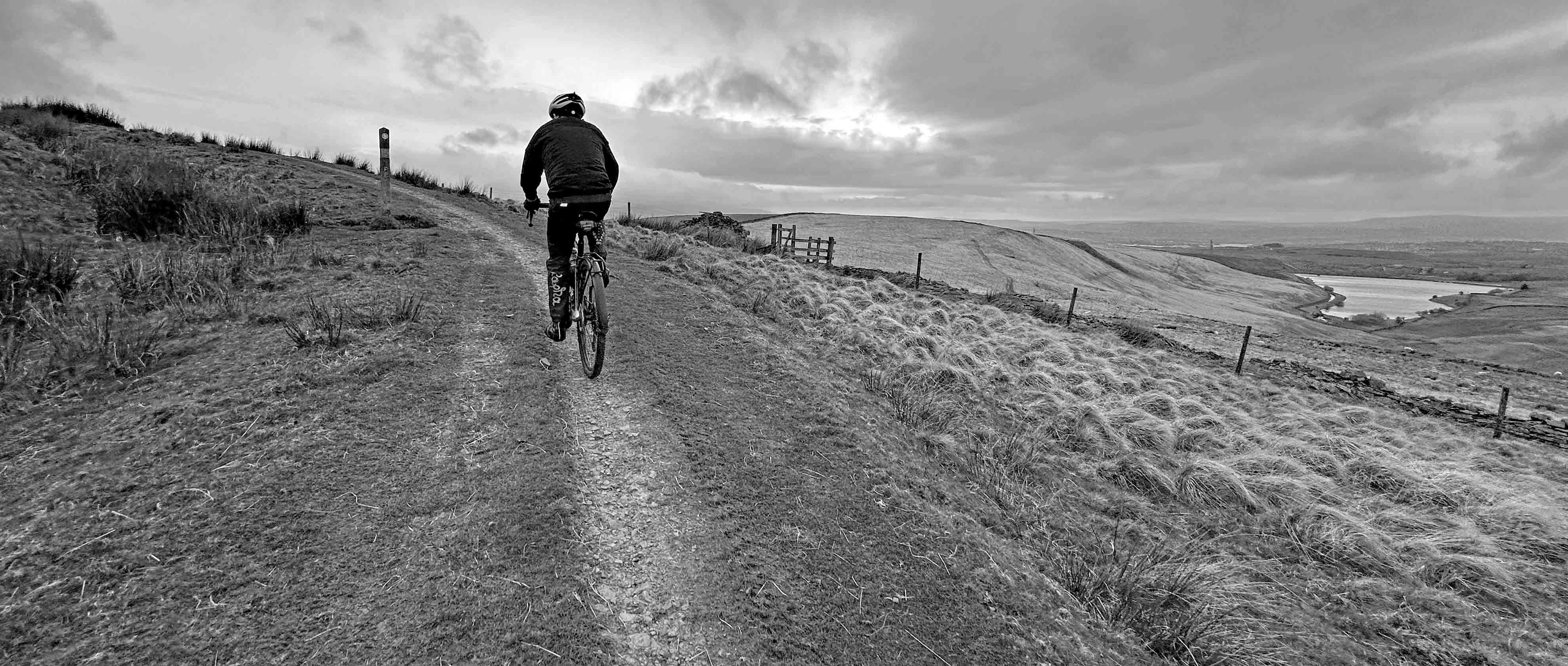
With the initial steep pitch successfully tamed, the next technical section was soon on us. We were following a singletrack trail and by craning our necks up the hill, it was obvious that the trail climbed again, but this time via a series of hairpinned corners. It was one of the those trails where you would need a drone to capture the skill and artistry of the trail builders’ craft, but the gradient, the pitch of the corners and the trail’s surface looked as though they had been custom-built for a gravel bike. At each corner, all you needed to do was lean to the inside, turn your head to look at the exit point and pedal smoothly. It actually felt like some kind of wizardry. How could so much height be gained so rapidly, but in a fun way that felt like you had to only make minimal effort to arrive at the top?
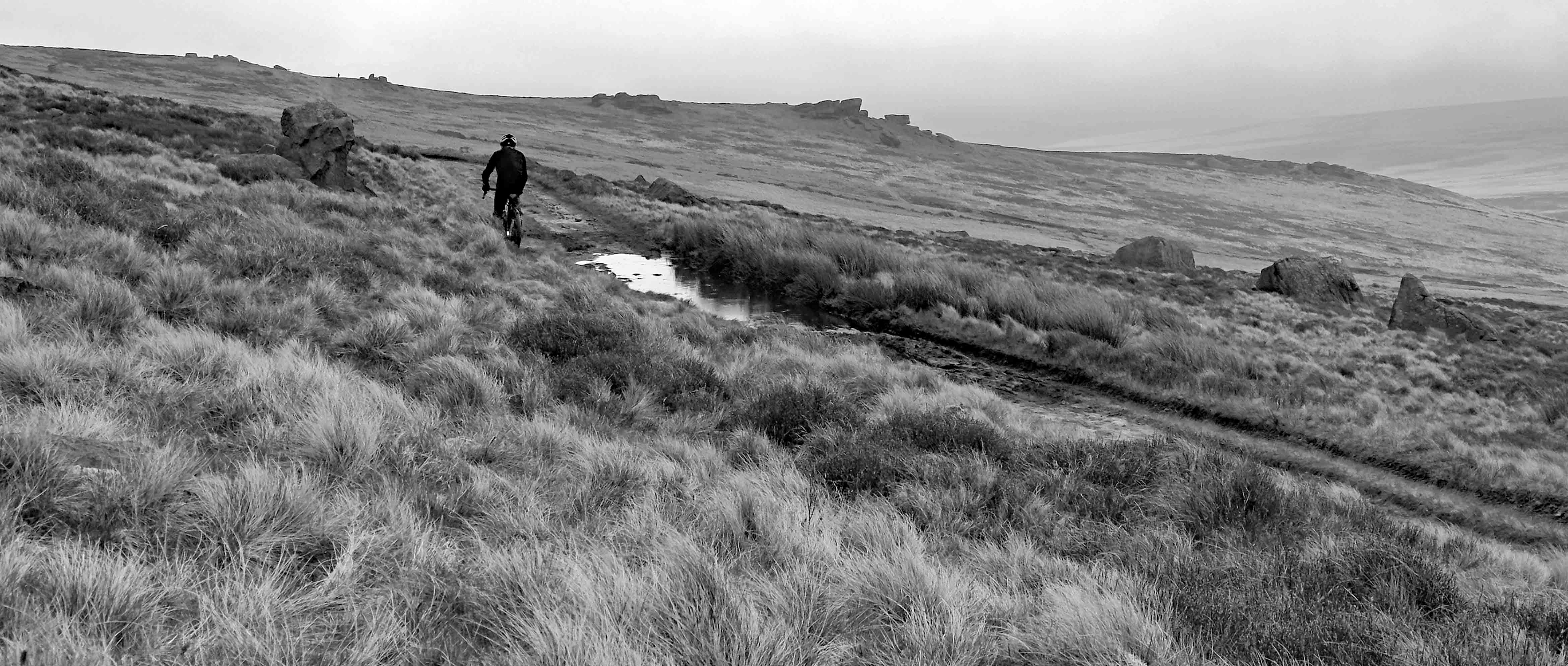
As the trail levelled out, I grabbed my phone out from my jersey pocket and connected via Bluetooth to the Flow App which controlled the motor on the Grizl:On. Miraculously, despite us having climbed around 900m at this point, by staying in Eco mode, Kelvin had only used 40% of the bike’s battery capacity. This boded well for us getting home with battery life to spare, particularly as we were now nearly at the highest point for miles around.
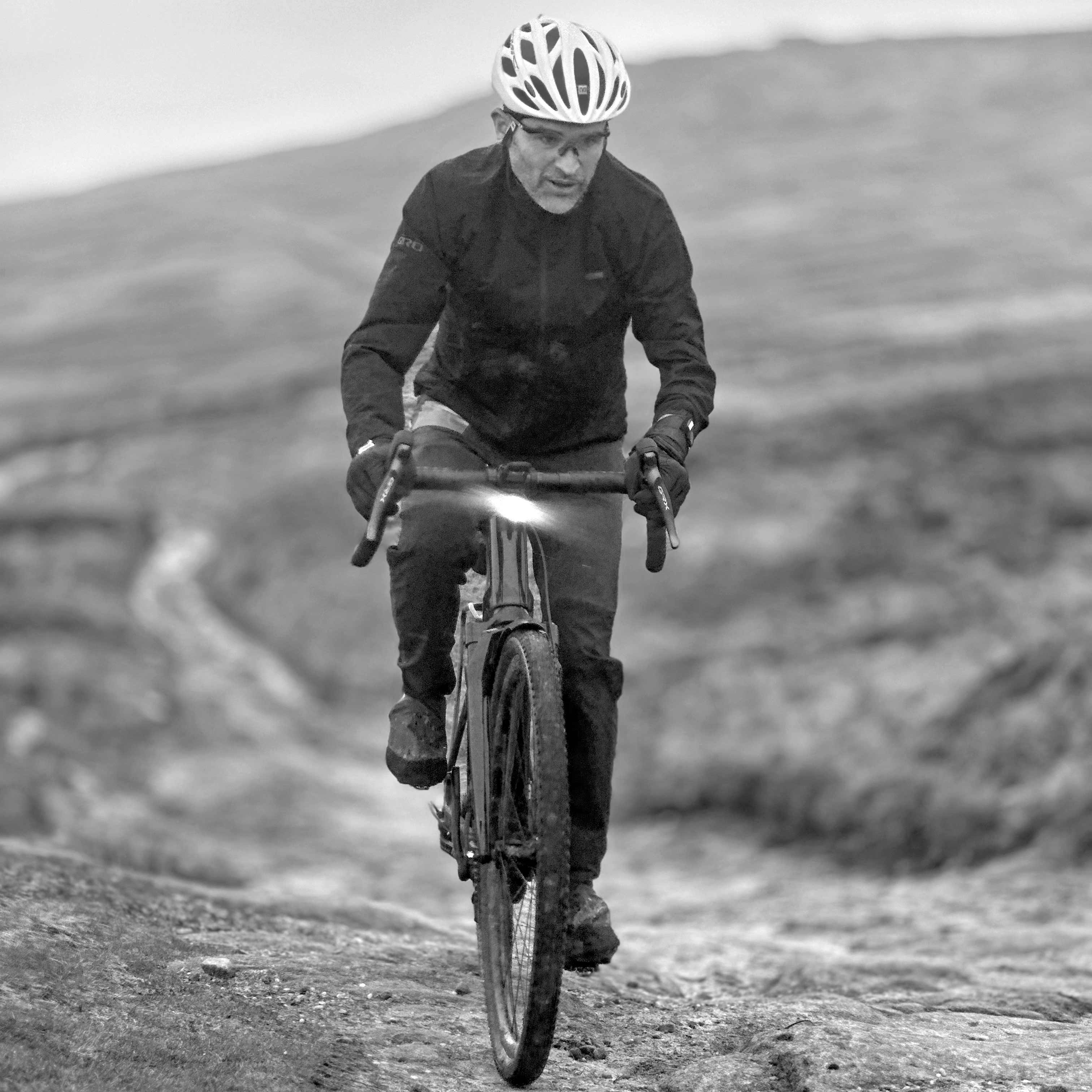
“There’s a little techy climbing section just before the top” was Kelvin’s heads up for me. By this point, the surface of the vehicle width trail had deteriorated quite significantly. Water damage was evident everywhere and there were some large puddles filling the trail from edge-to-edge. By scanning further along the trail, it was obvious which was the steeper section that Kelvin was talking about. As we rode closer, you could see the make-up of the trail’s surface on this final section – gritstone bedrock, incised with millennia-old runnels, liberally coated with loose pebbles and larger fragments of broken rock. Although it was pretty steep and our legs were already letting us know how much climbing we previously done, the ‘crux’ section of the trail was mercifully short and with some judicious body-English, it was possible to ride up it without too many difficulties. I’d had a small head start as I approached the steeper section and I’d given it some beans too, hoping that momentum would help get me at least part of the way up, so I was super impressed when I looked around to discover that Kelvin was only just behind me. The combination of time-served rider skill and e-power was proving to be a winning one.

“My legs feel alright, so I’m going to go out on the MTB with some local friends tomorrow” was Kelvin’s pièce de résistance, dropped neatly into the conversation as I was packing my stuff into my van, ready for the drive back home. He already had two consecutive days of hilly rides in his legs, but despite the fact I was taking the Grizl:ON home with me, he decided he still had the energy to ride the following day too.

During the couple of days that we’d spent riding together, the Grizl:ON had proved to be a revelation. Like any tool, an e-gravel bike needs to be used appropriately and with a bit of thought. It would be all-too-easy to put it in turbo mode and have an easy ride everywhere (for a short period), but in my view, if you want to get the most out of it, think of it like a constant friendly tailwind rather than an alternative to pedalling. The bike had allowed us to ride further and with significantly more climbing than we might have otherwise achieved. It helped to perfectly synchronise our respective fitness levels. And it helped give Kelvin the confidence to ride again on a subsequent day as well.
Just based on this alone, I think we can safely say that “E’s are good”.